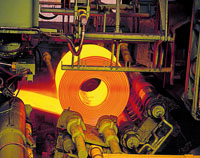|
One of the first major industrial plants in the world to have chosen a TETRA radio system for its on-site communications is large steelworks in Brazil, the Tubarão plant of ArcelorMittal. Located on the Atlantic coast some 430?km from Rio de Janeiro, the plant converts ores arriving from the Brazilian hinterland into iron and steel. It exports carbon steel coils and slabs by sea, for further processing by customers such as rolling mills. And it does all this on a spectacular scale, through a complex system of integrated processes, some involving temperatures up to 1600°C, molten metal and high pressures. With its blast furnaces, continuous casting machines and hot strip mill, it produces 7½ million tonnes of steel annually, on a site measuring some 7?km long and 4?km across. These processes continue 24 hours a day, every day of the year. “It’s said that in the company there’s no holidays”, jokes one of the radiocommunications team. For the safe working of the plant, reliable communications are vital – so essential that for even the most urgent maintenance work on the radio system, operations cannot be interrupted for longer than one or two minutes. Even then, special contingency plans must be prepared. “For some operations, it’s very important to count on that system”, said José Martins, automation engineering manager for ArcelorMittal. “Otherwise we could have a lot more risk and accidents in our operations.” Alongside the main steel production processes are a variety of supporting industrial plants and activities. For example, the coke needed to make steel is produced by huge ovens which cook the incoming coal, at the same time generating coal gas as fuel for the site’s 216-megawatt electricity generating station. There’s a pelletizing plant, a refinery for coal by?products and a cement plant with a capacity of one million tonnes per year. An extensive road network, including a dual three-lane main highway, connects all these facilities within the huge site (rule of the road is that you must give way to industrial vehicles) and it is criss-crossed by railway tracks. Time for changeUntil two years ago, the Tubarão plant relied for its radio communications on an EDACS analogue system from Ericsson, implemented in 1996. But change became unavoidable, partly because it was becoming impossible to buy replacement parts. “We had many terminals out of operation because of damage”, said Antônio Gagno, automation specialist at the plant. “Repair was not viable.” But in any case, performance of the analogue network – a 20-channel system with 1900 mobile terminals – no longer met the plant’s developing requirements. Radio coverage from its single base station was unsatisfactory because of shadowing by buildings, by the lush tropical tree cover on some parts of the site, and by ferromagnetic structures such as the large gas-holder and the coke ovens. On top of all that, new frequency plans imposed by the Brazilian telecoms regulator Anatel were shortly to make a switch to digital radio mandatory. “So we made a start, analysing the opportunities”, Mr Gagno continued. “And we established our objectives: a gradual implementation of a new trunking radio system (digital, as you will know, because of the regulatory agency); an open standard protocol (we had some problems with EDACS because it was not open); we wanted coverage of 100 per cent for voice and data; and interoperability with the analogue system (you have to migrate gradually). We made this interoperability by back-to-back [radios]. “So we decided to have 2000 terminals; 100 per cent coverage; after-sales service; system growth capacity; to have autonomous internal management and control (we decided to have our own because of our mission-critical work here); terminal robustness, because our operators have some These gateways would provide links to telephone and ISDN networks. One other requirement on the list was voice recording – both to meet legal requirements in Brazil and to enable safety-conscious plant managers to review any incidents which might occur in this critical environment. Selecting a systemTETRA was not the automatic choice. Other radio technologies examined by the team included the APCO P25 digital system and MPT 1327 analogue trunking technology – which would have been significantly cheaper. “But then we saw that the TETRA system had advantages like an open protocol and constant improvements, effective management, big number of suppliers”, Mr Gagno went on. “That’s very important for us – large market, lower prices, spare parts.”
|

 It’s not only in Europe and Asia that
It’s not only in Europe and Asia that